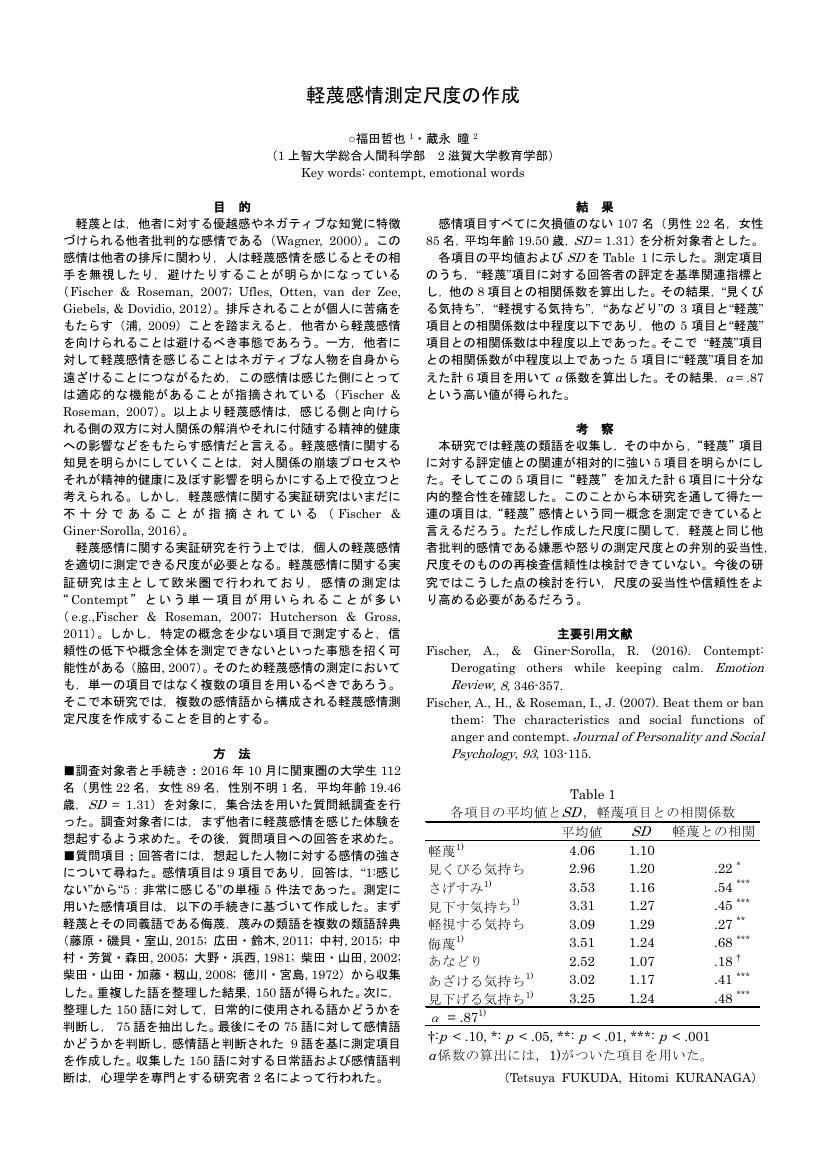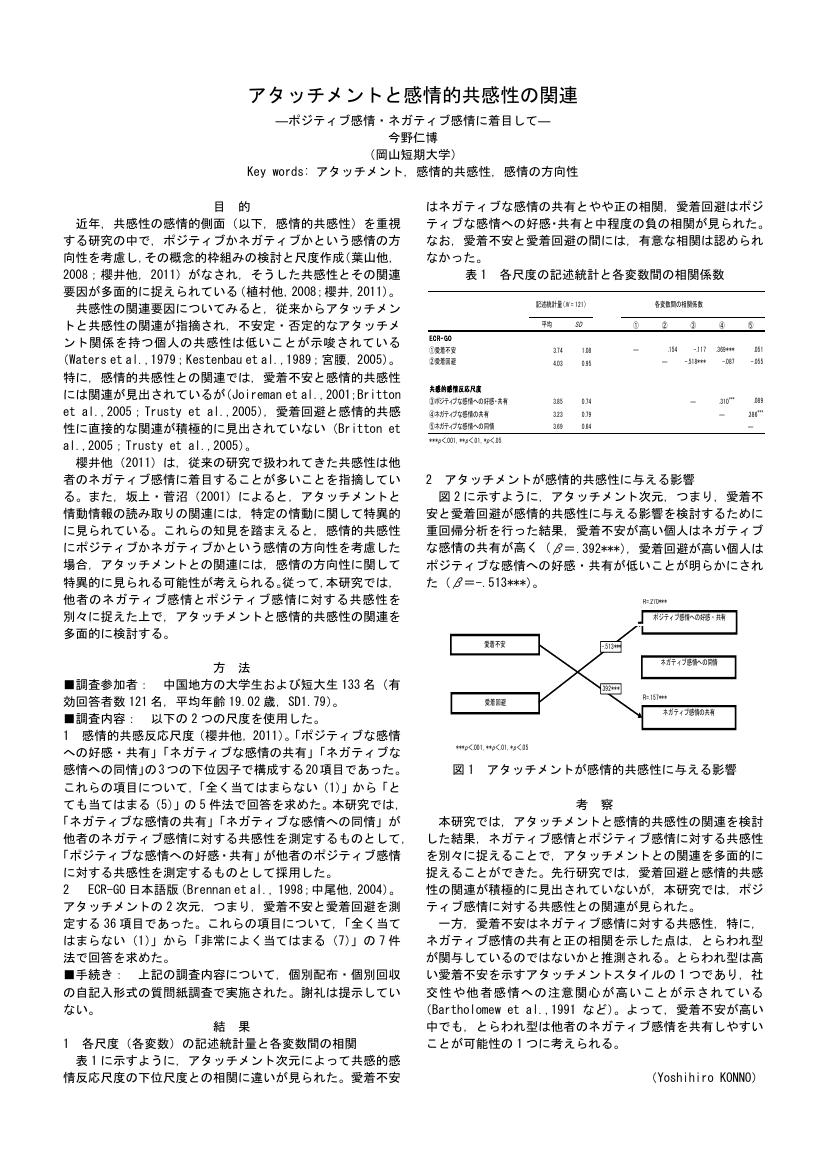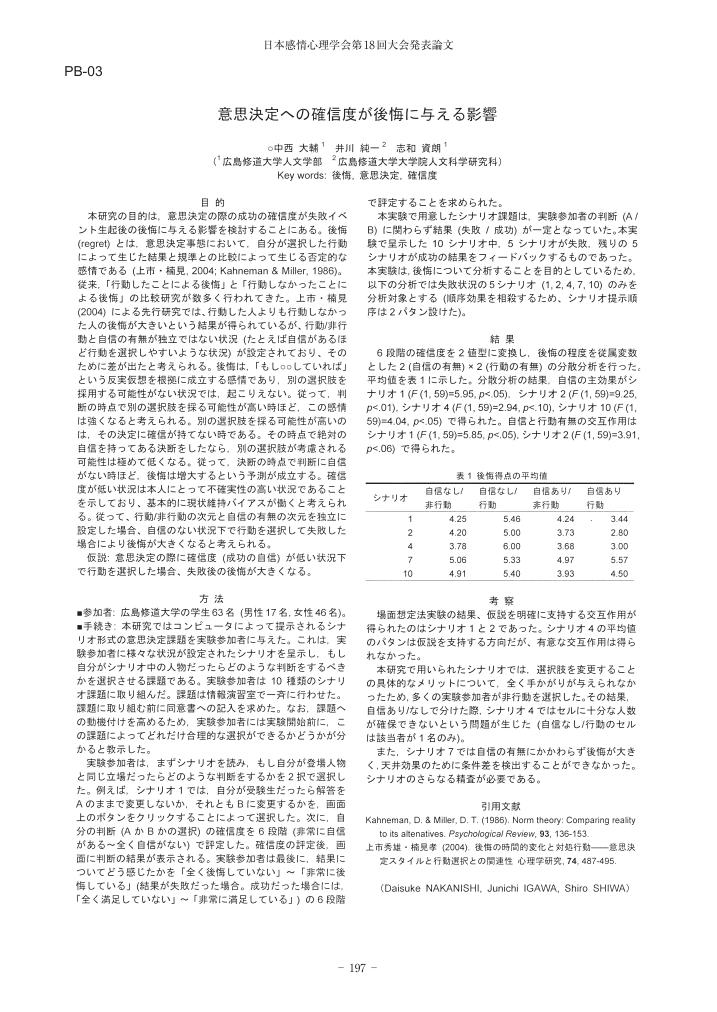1 0 0 0 OA 「苦しい」に関する感情体験の特性
- 著者
- 鈴木 賢男
- 出版者
- 日本感情心理学会
- 雑誌
- 感情心理学研究 (ISSN:18828817)
- 巻号頁・発行日
- vol.18, no.3, pp.196, 2011-05-15 (Released:2011-09-01)
1 0 0 0 認知的感情制御と抑うつ・不安の関連:―メタ分析による検討―
- 著者
- 榊原 良太
- 出版者
- JAPAN SOCIETY FOR RESEARCH ON EMOTIONS
- 雑誌
- 感情心理学研究 (ISSN:18828817)
- 巻号頁・発行日
- vol.22, pp.22, 2014
1 0 0 0 OA 比喩で表現される感情の種類の判別
- 著者
- 松尾 浩一郎
- 出版者
- JAPAN SOCIETY FOR RESEARCH ON EMOTIONS
- 雑誌
- 感情心理学研究 (ISSN:18828817)
- 巻号頁・発行日
- vol.5, no.2, pp.51-60, 1998-03-31 (Released:2009-04-07)
- 参考文献数
- 31
The purpose of this study was to search for the factors that contributed to the understanding of the emotions expressed by figurative language. In the preliminary study, 74 similes that express joy, sadness, and anger were selected. Eighty-four subjects rated 74 similes on SD scales. Factor analysis was conducted on the data. Throughout the factor analysis, two factors emerged. These two factors were interpreted as "activity" factor and "evaluation" factor. The distributions of similes in the three emotions were relatively different in the two-dimensional factorial space, namely the affective meaning space. Throughout the discriminant analysis, "activity" and "evaluation" factors contributed to the understanding of the emotions expressed by the similes.These findings indicated that understanding of the emotions expressed by the similes was based on those two foctors.
1 0 0 0 OA 軽蔑感情測定尺度の作成
1 0 0 0 OA ポジティブ情動喚起刺激の不確実性と重要性が情動持続に与える影響
- 著者
- 金子 迪大 堀毛 一也
- 出版者
- 日本感情心理学会
- 雑誌
- 感情心理学研究 (ISSN:18828817)
- 巻号頁・発行日
- vol.24, no.1, pp.33-41, 2016-11-30 (Released:2017-02-22)
- 参考文献数
- 30
This study examined the effects of uncertainty and importance of a positive emotional event on the duration of emotion. We hypothesized that (i) uncertainty reduces the rate of decreasing emotional reaction by extending the duration of attention to the event, and (ii) importance increases the initial emotional reaction but does not reduce the decreasing rate. Ninety-two participants answered an ostensible ability test and received bogus positive feedback as emotional manipulation. Next, uncertainty and importance of feedback were manipulated across three conditions. Participants in the uncertain condition were told that the ability measured would be disclosed after the experiment. In the important/unimportant conditions, participants were instructed that an important/unimportant ability had been measured. Next, participants reported on their emotional state and performed a filler task for five minutes, after which they reported on their emotional state again. Results showed that participants in the uncertain and important conditions experienced more increased initial emotional reaction and longer duration of emotion than those in the unimportant condition. Although the effect of importance was consistent with the hypothesis, the effect of uncertainty was not.
1 0 0 0 OA 自己反すうと自己内省が社交不安に及ぼす影響─4週間の間隔を空けた縦断的検討─
- 著者
- 小澤 崇将 長谷川 晃
- 出版者
- 日本感情心理学会
- 雑誌
- 感情心理学研究 (ISSN:18828817)
- 巻号頁・発行日
- vol.25, no.1, pp.17-25, 2017-10-31 (Released:2018-03-16)
- 参考文献数
- 28
- 被引用文献数
- 3
Possible effects of two forms of self-focus driven by different motives, self-rumination and self-reflection, on symptoms of social anxiety, were investigated. Undergraduates (N=200) completed the Rumination–Reflection Questionnaire, Liebowitz Social Anxiety Scale (LSAS), Short Fear of Negative Evaluation Scale (SFNE), and Interpersonal Stress Event Scale on two occasions with an interval of four weeks. Results indicated that self-rumination in the first session significantly predicted the subsequent increase in fear of negative evaluation assessed with the SFNE, even after controlling for the intensity of initial symptoms. This finding is consistent with previous studies showing that self-focus is a major factor in maintaining social anxiety. On the other hand, self-reflection in the first session predicted a decrease in subsequent avoidance behaviors from social situations assessed with the LSAS. These findings indicate that self-focus motivated by curiosity or an epistemic interest in the self might enable people to reconsider tendencies of avoiding social situations, which may prevent behavioral tendencies of avoidance. These findings suggested that motivations driving self-focus could determine its effects on the symptoms of social anxiety.
- 著者
- 糸魚川 幸宏
- 出版者
- JAPAN SOCIETY FOR RESEARCH ON EMOTIONS
- 雑誌
- 感情心理学研究 (ISSN:18828817)
- 巻号頁・発行日
- vol.22, pp.5-5, 2014
- 著者
- 金築 優 金築 智美 及川 昌典
- 出版者
- JAPAN SOCIETY FOR RESEARCH ON EMOTIONS
- 雑誌
- 感情心理学研究 (ISSN:18828817)
- 巻号頁・発行日
- vol.18, no.1, pp.42-50, 2010
- 被引用文献数
- 4
The purposes of this study were to develop the Japanese-version Affective Control Scale (JACS) and to investigate the relationship between fear of emotions and stress responses. In study I, we had 517 undergraduates completed the JACS. Results indicated the JACS had high internal consistency. Also, the subscales of the JACS were substantially intercorrelated. In study II, we had 348 undergraduates completed the questionnaire that assessed fear of emotions, neuroticism, trait meta-mood, and avoidance of negative emotions. Construct validities of the JACS were confirmed based on the correlations of these variables. In Study III, we had 140 undergraduates completed the questionnaire that assessed fear of emotions, coping strategies, and stress responses. As a result, fear of emotions was positively correlated with avoidance and stress responses. Theses results indicate that fear of emotions seem to be the factor linking coping strategies and stress responses. The theoretical and clinical implications of these results were discussed.
- 著者
- 中野 良樹 伊藤 由美
- 出版者
- JAPAN SOCIETY FOR RESEARCH ON EMOTIONS
- 雑誌
- 感情心理学研究 (ISSN:18828817)
- 巻号頁・発行日
- vol.16, no.3, pp.195-208, 2009
- 被引用文献数
- 2 1
Human communication of emotions is achieved through both facial and vocal information. The purpose of this study is to investigate the dominant sensory modality in recognition of emotions to the multi-modal expression. In Experiment 1, expressions of happiness, surprise, sadness, or aversion was presented vocally, facially, or in both modalities through the expression of an interjectory word "eh". Participants were required to judge the emotion that was expressed. In Experiment 2, recognition of conflicted emotions between modalities was investigated by combining different emotions between facial and vocal expression. Results of the two experiments indicated that the observers predominantly recognized happiness and surprise that was expressed facially rather than vocally. Furthermore, the expression of happiness was often mistaken as surprise, and the expression of sadness was often mistaken as aversion. Importantly, however, the reverse of these mistakes was little observed. Such the asymmetries of confusion were consistently obtained in every modality including bimodal presentations. This evidence is suggestive that an amodal processing system exists in multi-modal recognition of emotions.
1 0 0 0 美容整形意識の日韓比較―ソウルにおける面接調査
- 著者
- 張 燕 阿部 恒之
- 出版者
- JAPAN SOCIETY FOR RESEARCH ON EMOTIONS
- 雑誌
- 感情心理学研究 (ISSN:18828817)
- 巻号頁・発行日
- vol.20, pp.1-1, 2013
1 0 0 0 OA 感情制御を目的とした対人交流方略と精神的健康との関連
- 著者
- 浦野 由平
- 出版者
- 日本感情心理学会
- 雑誌
- 感情心理学研究 (ISSN:18828817)
- 巻号頁・発行日
- vol.24, no.3, pp.101-111, 2017-05-15 (Released:2017-06-13)
- 参考文献数
- 37
- 被引用文献数
- 2
We developed a measure regarding interpersonal strategies of emotion regulation, and asked 310 students to report on their daily use. As a result, we gained 7 interpersonal strategies: making others uncomfortable, doing something fun together, making a joke, ruminating together, reassurance seeking, problem solving together, and complaining. The new measure demonstrated appropriate psychometric properties. We found significant gender differences on strategy use and relationships between measures of mental health. Lastly, we discussed the limitations of the current study, and prospects for future studies.
1 0 0 0 OA 赤は女性をより魅力的にするか
- 著者
- 服部 陽介
- 出版者
- 日本感情心理学会
- 雑誌
- 感情心理学研究 (ISSN:18828817)
- 巻号頁・発行日
- vol.24, no.Supplement, pp.ps33, 2017 (Released:2017-04-03)
1 0 0 0 OA LINE上のコミュニケーションはユーザーにどう捉えられているのか
1 0 0 0 OA アタッチメントと感情的共感性の関連
- 著者
- 今野 仁博
- 出版者
- 日本感情心理学会
- 雑誌
- 感情心理学研究 (ISSN:18828817)
- 巻号頁・発行日
- vol.22, no.Supplement, pp.28-28, 2014 (Released:2014-12-05)
1 0 0 0 OA 顔文字付きメールが受信者の感情緩和に及ぼす影響
- 著者
- 荒川 歩 竹原 卓真 鈴木 直人
- 出版者
- 日本感情心理学会
- 雑誌
- 感情心理学研究 (ISSN:18828817)
- 巻号頁・発行日
- vol.13, no.1, pp.22-29, 2006-03-30 (Released:2010-01-15)
- 参考文献数
- 13
- 被引用文献数
- 2 1
This research compared the effects of messages with and without emoticons from a familiar friend on the reduction of intensity of emotions, the relationship between changes in emotions, and the impact of emoticons on text messages. In particular, the effect of messages with one of five emoticons { (^_^) (;_;) (>_<) (^_^;) m(_ _)m } and messages with no emoticons, on four emotional scripts, happy, sad, angry, and anxious, were compared. Using their own cell phones, university students (n=33) participated in this study by reporting emotional intensity when they were in each script. They again reported emotional intensity after receiving a text message with emoticons from a familiar friend. Results indicated that (1) messages with emoticons reduced the intensity of the receiver's negative emotions in comparison to messages without emoticons; and (2) when receivers were feeling angry or happy, a significant relationship was found between the impact of emoticons and the reduction in the intensity of emotions, expect when receivers were feeling anxious or sad. Results suggest that appropriate selection from emoticons reduces the intensity of the receiver's negative emotions.
1 0 0 0 教師の受容的態度および学級での三者関係が児童の感情に及ぼす影響
- 著者
- 大久保 智生
- 出版者
- 日本感情心理学会
- 雑誌
- 感情心理学研究 (ISSN:18828817)
- 巻号頁・発行日
- vol.22, pp.27, 2014
1 0 0 0 東日本大震災・復興活動に対する感情的地域差
- 著者
- ウィワッタナーパンツウォン ジュターチップ 本多 明生 阿部 恒之
- 出版者
- JAPAN SOCIETY FOR RESEARCH ON EMOTIONS
- 雑誌
- 感情心理学研究 (ISSN:18828817)
- 巻号頁・発行日
- vol.21, pp.10-10, 2013
1 0 0 0 状況による安堵感の差異
- 著者
- 柴田 利男
- 出版者
- JAPAN SOCIETY FOR RESEARCH ON EMOTIONS
- 雑誌
- 感情心理学研究 (ISSN:18828817)
- 巻号頁・発行日
- vol.21, pp.28-28, 2013
1 0 0 0 OA 意思決定への確信度が後悔に与える影響
1 0 0 0 OA 腹式呼吸法の実施に伴う生理・心理的変動(1)
- 著者
- 高橋 研人 佐藤 俊彦
- 出版者
- 日本感情心理学会
- 雑誌
- 感情心理学研究 (ISSN:18828817)
- 巻号頁・発行日
- vol.23, no.Supplement, pp.ps31-ps31, 2016 (Released:2016-08-24)






